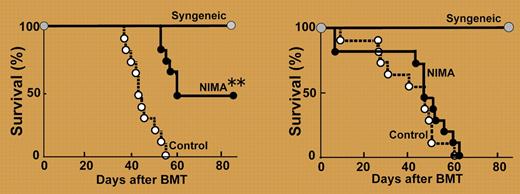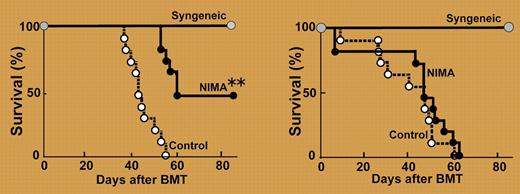Comment on Matsuoka et al, page 404
Fetal tolerance to noninherited maternal antigens (NIMAs) improves the outcome of a haplotype-mismatched stem cell transplantation by an antigen-specific CD4+CD25+ T regulator cell in mice and possibly also in humans.
Matsuoka and colleagues report that stem cell grafts from H-2b/b offspring exposed during pregnancy and breast feeding to NIMA H-2d caused less graft-versus-host disease and better immune reconstitution when used as donors to their H-2b/d mothers than maternal H-2b/b grafts exposed during pregnancy to the H-2d inherited paternal antigens (IPAs) given to their H-2b/d offspring. They further present convincing evidence that CD4+CD25+ antigen-specific T regulator cells play a dominant role in this NIMA effect (see figure) and conclude that their “findings may therefore have profound implications on the performance of clinical bone marrow transplantation...” (see the Abstract of their article on page 404 of this issue).
They might well be correct. In a nation-wide collaborative effort, Japanese transplant centers have recently confirmed and extended evidence that T-cell-replete sibling-to-sibling donation is possible, if the donor is mismatched for NIMA and shares the IPA using standard conditioning and routine graft-versus-host prophylaxis. Likewise, offspring can be used successfully as stem cell donors to the mother. In contrast, although some maternal-to-offspring grafts do well, overall they cause more severe graft-versus-host disease.1,2 The clinical relevance of the NIMA effect finds further support in the finding that renal allografts from haploidentical, but NIMA-mismatched siblings do as well as HLA-identical siblings.3
Many questions remain unanswered, however, both in the Matsuoka paper and the clinical studies. The mouse experiments should be considered as a model for a single patient. Only 2 H-2 haplotypes were studied: H-2b and H-2d—the Achilles heel of many mouse model studies. It might well be that H-2 haplotypes other than H-2b and H-2d might give acceptable results in the mother-to-offspring transplantations. Furthermore, the mice used were only 8 weeks of age. The situation in adult mice and humans after heterologous immunity has had its impact on the regulation of the immune response could be different. Although the data are significant and all have been done at least in duplicate, the results are not: all or none, the NIMA-exposed grafts resulted in only a 50% to 70% success rate. It follows that factors other than NIMA exposure influence the outcome as well. Obvious variables are the moment and quantity of mutual chimerism, which occurs during pregnancy, and breast-feeding. The model could be further “humanized” by using not 2, but 4 different haplotypes, as this has been shown in humans to influence tolerance induction.4
Information on immunity (both humoral as well as cellular) or tolerance of the mother against IPA and whether this influences the NIMA effect is obviously relevant, but lacking in all publications.
The authors conclude their paper by pointing out that their findings could help “to develop new strategies for using a NIMA-mismatched donor in the absence of an HLA-identical donor,” and I agree. Only about 1 of 2 patients looking for an unrelated stem cell donor receives a transplant. A shortage of well-matched donors, delays in finding them, and lengthy work-ups are all causative factors.5 Cord blood transplantations and haploidentical T-cell-depleted donors can help some of these patients. The NIMA-mismatched sibling or offspring donor should not be forgotten, either. ▪
After stem cell transplantation with NIMA-exposed T cells, half the recipients survived (left). They all died after removal of the CD4+CD25+ T cells from the inoculum (right). See the complete figure in the article beginning on page 404.
After stem cell transplantation with NIMA-exposed T cells, half the recipients survived (left). They all died after removal of the CD4+CD25+ T cells from the inoculum (right). See the complete figure in the article beginning on page 404.



